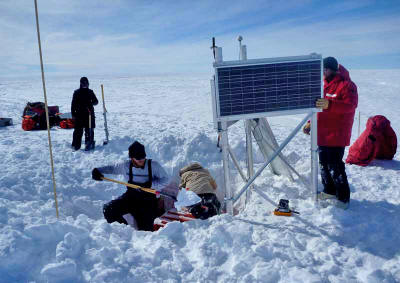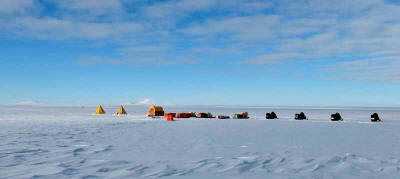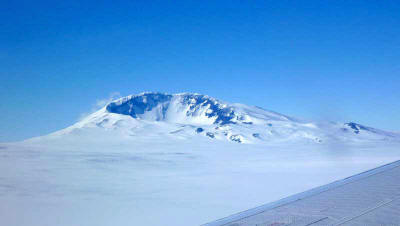|

by Andrea Mustain
Staff Writer
06 April 2012
from
LiveScience Website

Researchers
hard at work around a seismograph,
an instrument in the
orange box buried in a hole in the snow.
Solar power runs the
seismic station during the summer,
and batteries keep it
going during the long, dark winter months.
CREDIT: Doug Wiens.
Thanks to a technological explosion in
the century since humans first set foot at the South Pole, Antarctic
research is thriving.
Yet despite the incredible scientific advances, there are still
gaping holes in some very basic knowledge about the frozen
continent. Namely, what, exactly, is under all that ice.
It's not simply a question for idle speculation. Figuring out what's
going on underneath the colossal Antarctic ice sheets is one
important puzzle piece in better forecasting what is happening to
the ice itself in a changing climate, some glaciologists say.
Scientists have used radar and other imaging technology to uncover
some astounding finds under the East Antarctic Ice Sheet:
A
vast
mountain range that rivals the Alps, and
Lake Vostok, one of Earth's
largest lakes.
But many scientists are trying to peer deeper still. They want to
map the rock that lies many miles beneath the bottom of the ice
sheet - in particular, the West Antarctic Ice Sheet.
Sensors used to detect earthquakes are
helping in that goal.

The installation of
the seismograph network is part of a project called Polenet.
Here, traveling
researchers have set up camp for the night.
The camp faces north
toward Mount Waesche, left, and Mount Sidley, in the middle.
CREDIT: Mike Roberts.
Westside is
the quest side
Researchers have wanted to essentially perform a CAT scan of West
Antarctica's geological underpinnings to a depth of about 60 miles
(100 kilometers), said seismologist Doug Wiens, a professor
of Earth and planetary science at Washington University in St.
Louis.
"There are certain qualities about
Antarctica that make it particularly interesting," Wiens told
OurAmazingPlanet.
By installing a network of seismographs
- instruments that record the energy waves from faraway earthquakes
- to map out the qualities of the rock deep below the surface, Wiens
and a team of researchers hope to figure out "what effect the Earth
has on the ice sheet." The project is called Polenet. [See images of
the scientists at work in Antarctica.]
Seismograph data can help reveal how mushy the rocks are, and how
heat is distributed throughout them - a big deal for understanding
the network of mechanisms that govern changes in the ice sheet.
Because Antarctica has been covered with thick ice for many
thousands of years,
"the whole continent is pushed
down," Wiens said. "If you melted all the ice off, it would move
back up."
Charting how viscous the underlying
mantle - the colossal rocky layer directly below the Earth's crust
that, though rigid as steel, still "flows" - will help researchers
figure out how fast different parts of the continent would rebound,
he said.
"We think hot areas of the mantle
will flow easier, so they'll pop up faster," Wiens explained.
Cold areas, on the other hand, wouldn't
flow so easily.
"Sort of like molasses you've put in
the freezer," he said. "It doesn't flow, so it won't pop up very
fast."
The question of heat distribution and
flow from the mantle to the crust is also an important one, he said.
There is compelling evidence that watery-bottomed glaciers flow
faster - and scientists have observed a marked speed-up in many
Antarctic glaciers in recent years. However, it's not clear what's
driving the acceleration. Warming oceans are likely playing a big
role.
Geology might also be a factor.
"It might have a big effect on the
ice sheet and might explain some observations," Wiens said. "If
you have a large heat flow from the mantle in a given area, it
may form water at the bottom of the ice sheet."
Finally, seismographs can reveal hidden
sources of seismic activity - little earthquakes that could be the
signatures of active volcanoes hidden under the ice. [Antarctica:
Solving Geologic Mysteries]

Mount Sidley, the
highest volcano in Antarctica,
may have a lot of
company lurking out of sight.
Scientists are using
seismographs
to hunt for hidden
volcanoes in Antarctica.
CREDIT: Doug Wiens.
Success, at
last
This year, for the first time ever, Wiens and his colleagues have
the data in hand to actually fulfill this geological vision. Until
recently, Antarctica's brutal conditions destroyed instruments after
only a few months.
But improvements in batteries and data storage have allowed
researchers to run a network of about 35 seismographs since 2007,
enough time to get a decent picture of what is happening under the
West Antarctic Ice Sheet.
This last field season, in late 2011, a team trekked across West
Antarctica to retrieve seismographs that have been busily recording
years' worth of data. Researchers are now poised to begin the long
work of figuring out what it all means.
In the end, the work will reveal
long-held Antarctic secrets.
"It's really the first time we're
able to look at the interior structure of the mantle," said
Andrew Lloyd, a WSLU Ph.D. student who traveled hundreds of
miles by snowmobile to help retrieve some of the seismographs -
and the reams of data they recorded.
"It will enable us to say something really definitive about the
tectonics and geology of the region, which is something nobody
has been able to do before," Lloyd said.
Wiens said that the data are already
revealing a tantalizing picture of what is going on beneath West
Antarctica, a place that is, in the words of one scientist,
"hemorrhaging ice."
"We do see these big variations in
the temperature in the mantle across parts of Antarctica that
will have a big effect on the ice sheet," Wiens said.
However, he added, many months of work
lie ahead, and it will be some time before scientists are ready to
announce to the world what lies beneath the ice.
|



